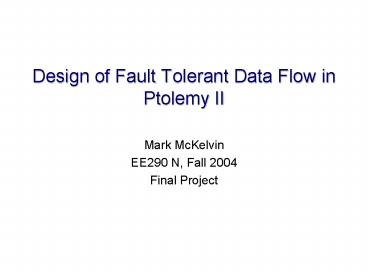Design of Fault Tolerant Data Flow in Ptolemy II PowerPoint PPT Presentation
1 / 10
Title: Design of Fault Tolerant Data Flow in Ptolemy II
1
Design of Fault Tolerant Data Flow in Ptolemy II
- Mark McKelvin
- EE290 N, Fall 2004
- Final Project
2
Motivation
- Designers of safety critical, cost sensitive
applications commonly use block diagrams to model
system component interactions - Block diagrams define the topology of the system
and data dependencies among components - Components may be distributed across a hardware
platform and characterized by redundant software
and hardware components to improve reliability - Creating design environments and tools based on a
precise models of computation to aid formal
techniques, Fault Tolerant Data Flow (FTDF) - Examples Deriving fault trees from a system
specification, automatically generating code on a
distributed platform
3
Fault Tolerant Data Flow
- FTDF is an experimental model of computation
amenable to describe periodic feedback control
systems, i.e. controlling a plant (Pinello, 2004) - A data flow variant introduced as a formalism for
which automatic techniques for formal analysis
and validation can be performed - A FTDF specification is composed of functional
components (actors) and communication media
(channel buffers)
4
FTDF Semantics
- A data flow process F is computed as a sequence
of firings that are enabled by a firing rule - f is a (possibly partial) function that must be
defined for all firing rules of an actor and is
finite - We can proceed to find a least fixed point by
repeatedly firing the actor based on its firing
function such that the firing rules are
satisfied, and in doing so, we define the
operational semantics of a data flow process - In FTDF, an actor can fire on a subset of inputs
Actor
outputs
F, f
inputs
5
Rules of Composition
- Given a set of actors, A, and a set of
communication media, M, connecting actors, a FTDF
graph, G (V, E) where V A and E M - Legal FTDF Graph Constraints
- G contains no causality cycles
- A legal graph must start with source actors and
complete a cycle with sink actors - All actors in graph G must execute at least once
before a new cycle begins - FTDF tokens are exchanged on each cycle with
synchronous semantics - Based on these constraints for composition, we
can determine the data dependencies of the Actors
in the graph. It determines the order, or
schedule, which actors may fire and communication
may occur
6
FTDF Assumptions
- A fault event in nodes in the FTDF graph assume
fail silence - Fail silence produces correct results or
produces no results at all - In general, fault events could be generated due
to - Processing element fault
- Communication media fault
- Actor fault (i.e. may be due to failure or
producing invalid outputs) - However, I simplify by only assuming an actor
fault since the graph is flattened and no fault
on communication channel
7
Implementation
- Requirements
- 1. For each actor in a graph, a firing function
is defined that satisfies each actors firing
rules - 2. Construction of a legal FTDF graph
- Ptolemy II
- 1. If requirements above are satisfied, all
actors are placed in a list and ordered based on
functional dependencies - 2. Each actor executes according to a schedule
known before compile time - 3. If an actor cannot fire, an Exception is
thrown alerting the designer that an actor cannot
fire due to not satisfying its firing rules
8
Conclusions and Open Issues
- Scheduler for the FTDF domain is constructed in
Ptolemy II - Programming issues and bugs with remainder of the
FTDF domain still needs resolving - Bounded memory execution?
- Yes. Synchronous semantics ensures only one
firing per cycle for any upstream actor - Is such a domain useful?
- Possibly adjusting FTDF behavior to other
existing domains - What if tokens arrive out of order, late?
- Can FTDF models be statically scheduled as in
SSDF (Statically Schedulable Data Flow) - Its possible, but balance equations must be
dynamically altered between cycles
9
References
- C. Pinello, L. P. Carloni, and A. L.
Sangiovanni-Vincentelli. Fault-tolerant
deployment of embedded software for
cost-sensitive real-time feedback-control
applications, Proc. Conf. Design, Automation, and
Test in Europe (DATE), 2004. - S. Edwards, L. Lavagno, E. Lee, A.
Sangiovanni-Vincentelli. Design of Embedded
Systems Formal Methods, Validation and
Synthesis. Proceedings of the IEEE, vol. 85(n.3)
March 1997, p366-290. - E. A. Lee and T. M. Parks, Dataflow Process
Networks,'', Proceedings of the IEEE, vol. 83,
no. 5, pp. 773-801, May, 1995. - E. A. Lee and D. G. Messerschmitt, Static
Scheduling of Synchronous Data Flow Programs for
Digital Signal Processing,'' IEEE Trans. on
Computers, January, 1987.
10
Reliability Block Diagrams
- RBDs are diagrams for representing how components
of a system are arranged and structurally
connected in terms of reliability - Commercial Tools Relex RBD (Relex Software
Corporation), BlockSim (ReliaSoft)
B
D
1/2
A
C

